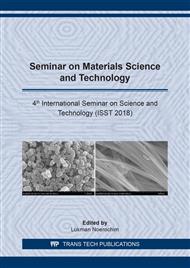p.1
p.7
p.13
p.19
p.26
p.33
p.40
p.45
Analysis of Cylindrical Briquette Dimension on Total Iron Content and the Degree of Metallization in Direct Reduction Process of Iron Ore and Iron Sand Mixture
Abstract:
Indonesia has abundant resources or raw materials, especially the iron sand raw materials. But, the iron sand processing in Indonesia is still low. Even though, the steel demand in Indonesia is still high. So, the iron sand processing product as raw materials in steelmaking is the solution of it. In this research, the study was conducted by using the variation of briquette dimension of mixture of iron sand and iron ore in Direct Reduction process. The aim of this research is to study the effect of briquette dimension on Fe content and degree of metallization of the Direct Reduced Iron (DRI). First, the iron sand and iron ore were crushed and shieved until pass the 50 mesh standar size. Then, iron sand and iron ore were mixed and briquetted based on the variation of dimension. There are three variations of briquette dimension. Then, the briquettes was reduced at 1250°C for 12 hours. The reduced briquettes then were analyzed using XRD, XRF and degree metallization calculation. The result showed that the dimension of briquette affect the Fe content and the degree metallization of DRI. The dimension of briquette will affect the reductor gas flow in the crucible, so the rate and direction of reduction process of iron oxide will be affected too. The best briquette is Briquette B (7.9 cm for inside diameter, 15.1 cm for outer diameter and 19.5 cm for the height), with 75.02% for Fe total content and 66.52% for degree of metallization. This was due to The briquette B has the most evenly diffused dimension either vertically and horizontally.
Info:
Periodical:
Pages:
19-25
Citation:
Online since:
July 2019
Keywords:
Price:
Сopyright:
© 2019 Trans Tech Publications Ltd. All Rights Reserved
Share:
Citation:


